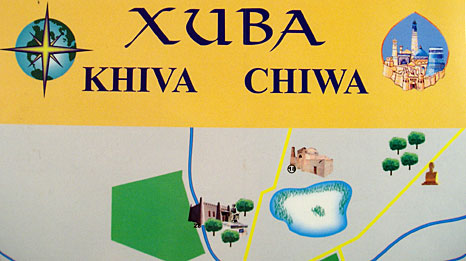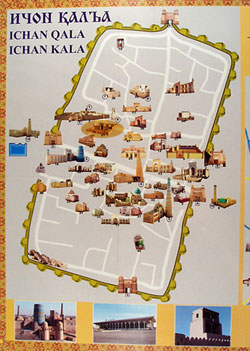|
A careful examination of this image reveals a great deal. The upper left-hand corner displays a label of two words repeated three times. The sound of the name, in Uzbek, of this walled section of the city appears in two different alphabets. The first is the name written in the Cyrillic alphabet, the alphabetic letters in which Russian and several other Slavic languages are written, and in which Uzbek was written before the breakup of the Soviet Union. The next two are written in Latin letters, Ichan Qala and Ichan Kala. The differences between these two may seem to be two different ways to spell the same name, but actually indicate variations in transliteration systems. The first is a transliteration system based on English language conventions for representing sounds; the second a German one.
Compare these representations of words with the label of the map that displays the name of the city as a whole, Khiva. This large label is placed on the page to the right of the representation of Ichan Qala. The largest word, placed in the center, is in Cyrillic letters. “Khiva” on the left represents the transliteration by English standards and “Chiwa” on the right, those in German.

What can we understand about the intended audiences of this image of the city from the representations of alphabetic letters? The audience given primacy of place in both labels is one that reads the Cyrillic alphabet. What is interesting to note is that on this side of the map an absence occurs. When, after the breakup of the Soviet Union, Uzebekistan became an independent country, it officially adopted Latin letters for its language. “Khiva” in contemporary Uzbek is spelled Xiva. Representing the name of the city in its new alphabet is present only on the other side of the map when it is fully opened. Of course, the use of Latin alphabetic letters is quite new, and most people who speak Uzbek are more used to seeing it represented in the Cyrillic alphabet. In addition, most of the adult population of Uzbekistan and the neighboring countries are also literate in Russian and thus familiar with the Cyrillic alphabet.
The other audiences to which this map is aimed are those literate in English and German. On the reverse side of this page where the Index to the numbered buildings is located, flags indicate the language by nationality. The Uzbek flag, British flag, and German flag are represented. The Uzbek section is presented in Cyrillic letters, and the English and German names are presented according to the transliteration systems in those languages, as on the front side.

Look again at the representation of the old section of Khiva, the Ichan Qala. Note the walled, rectangular enclosure with gates in each of the four sides. Note the number of buildings represented within the walls with some outside them. Look at the representation of streets. All of the buildings are facing us directly or are presented so that we see the building as a whole.
For example, number 21, the khan-madrassa of Muhammad Rahim. Naturally, if we were on the street in the Ichan Qala, we would not see the building in this fashion. This image of the city shares many similarities with the images of cities that developed in the 19th century and have continued since then.

This type of mapping presents a “bird’s-eye” view of the street layout of the city, one that a pedestrian cannot see but which helps the user of the map navigate connections of streets. It promotes knowledge of the overview of a city. In the 19th century, such maps usually represented buildings by displaying their ground plans. The pedestrian, of course, would not see the ground plan as she walked through the city, but the ground plan represented an expected typology of buildings. The users of such maps are usually not local inhabitants. Such maps do not represent all buildings, but only those deemed important. The map of the Ichan Qala follows in this tradition and displays only important buildings.
Absences occur in this image of Ichan Qala. No street names appear. Perhaps the streets have no names. Scale is not represented. How large is this section of the city? Are the buildings represented to scale? No indications as to the site of the buildings are present. For example, the facade of the Shergozi kahn-madressa, number 11, faces the viewer, but appears to have its back to the street. How is access to the building achieved? What is the spatial relationship between buildings? In one glance, each is shown clearly to the viewer and no buildings overlap.
For whom then, and why, is this kind of image of the city made? The legend on the reverse tells us that Shams al-Din Matasulov produced this map in 2003.

In addition, the legend tells us that since 1990, the Ichan Qala of Khiva was recognized by UNESCO as a world historic monument. These words reinforce the close reading of the map. The image of the Ichan Qala serves as a visual catalog of its monuments, a type of catalog made possible by digital technology. The formal designation as world historic monument also helps to explain the choice of languages and alphabets used on the map. If Uzbek were written in the new alphabet, all those who were not literate in Latin letters would be excluded as an audience. Those who can read the Latin alphabet have access to most of the information through the English and German. Finally, and importantly, this image of Ichan Qala—produced on a computer, rendered on paper, and widely available at a modest price—places the city of Khiva in a global visual world of monuments.
 
|

